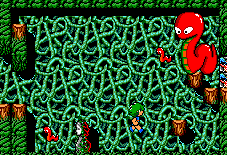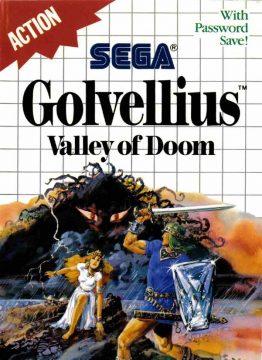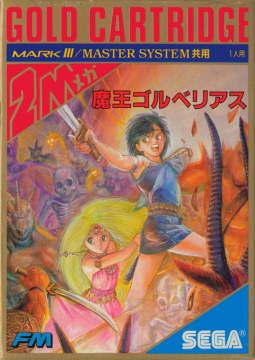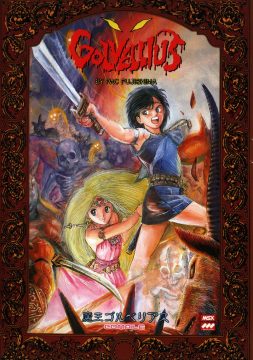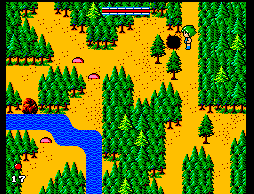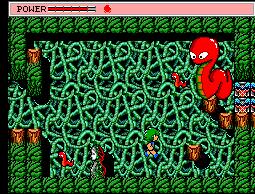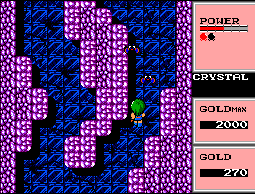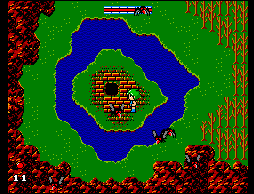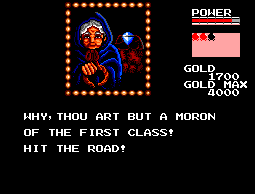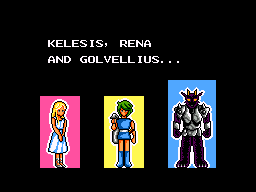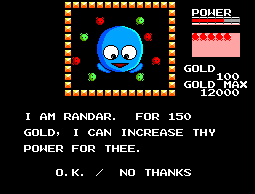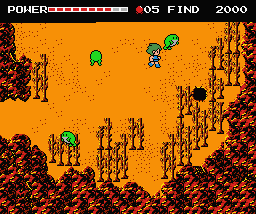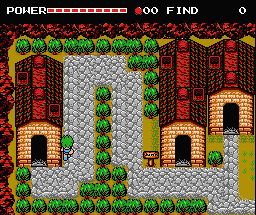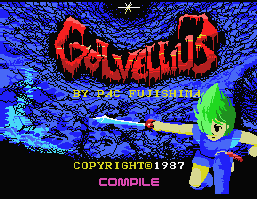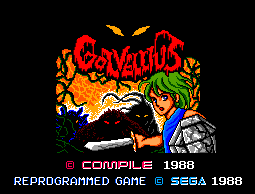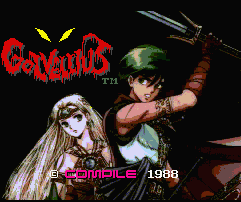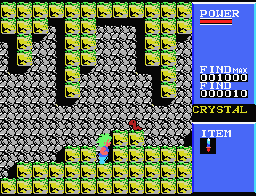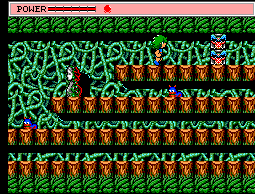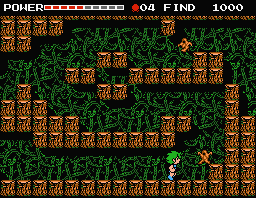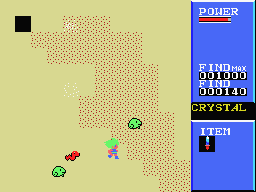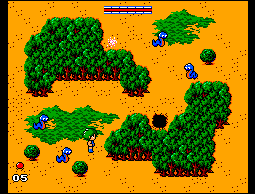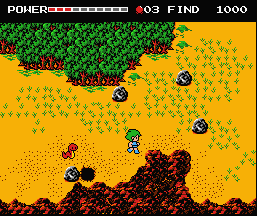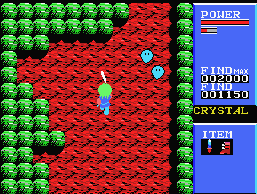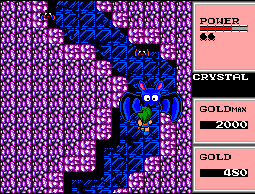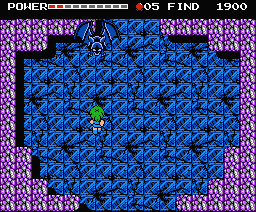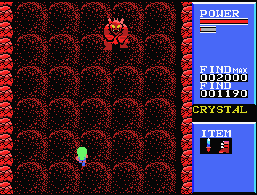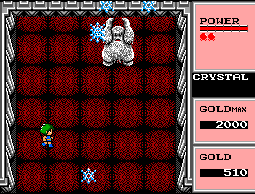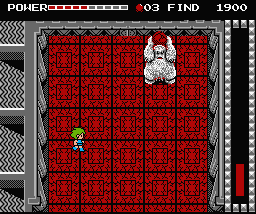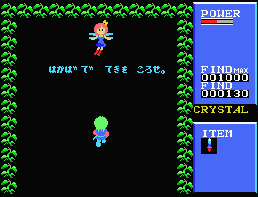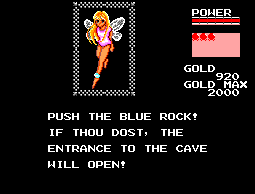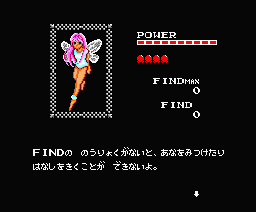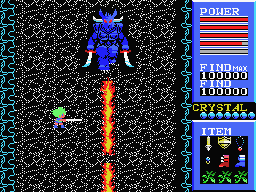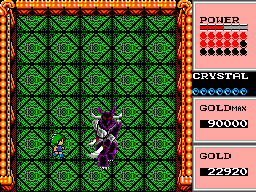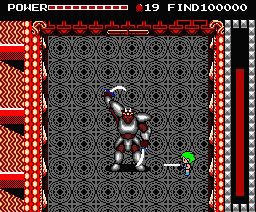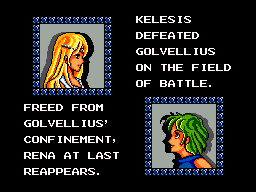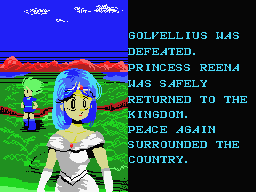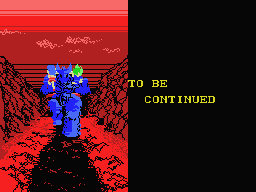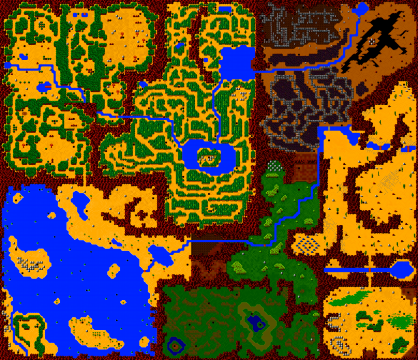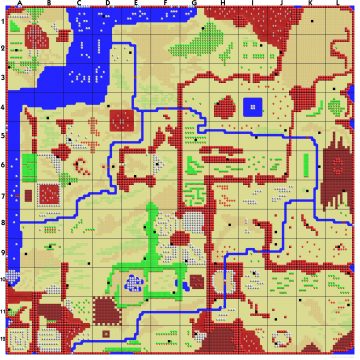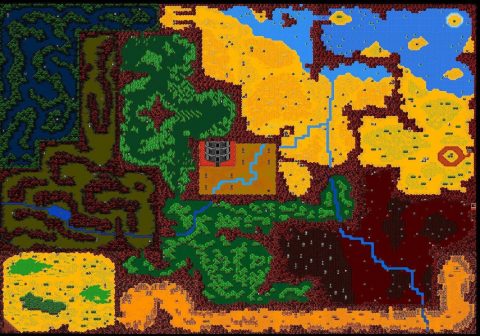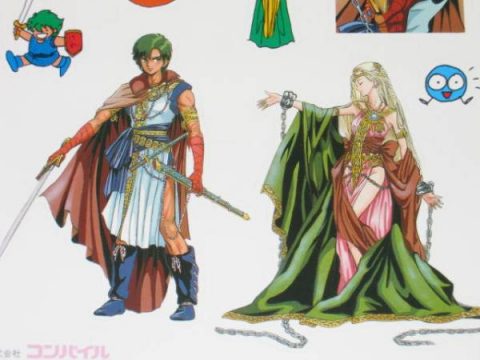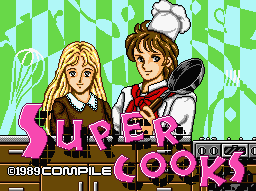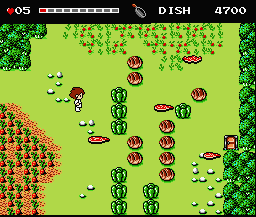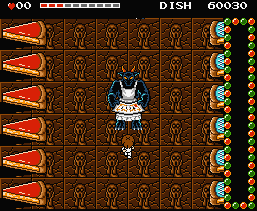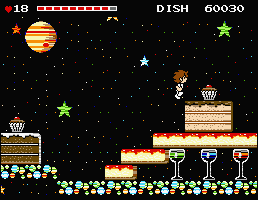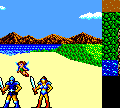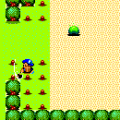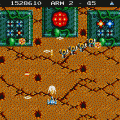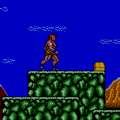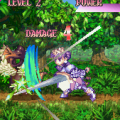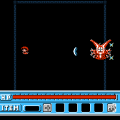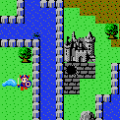You could take one look at Golvellius: Valley of Doom, and quickly dismiss it as a Legend of Zelda clone. In some ways, that’s true – this overhead action-RPG is indeed inspired by Nintendo’s classic. But like a lot of games for the Sega Master System, it takes concepts from its competitors and reshapes them to create unique products that are just as amusing. (At least this was true until Sega released Golden Axe Warrior, which is a pretty blatant plagarization of Zelda.)
Golvellius is actually the name of a big demon brute, the kind that video games heroes like to kill. This particular video game hero is named Kelesis, a fearsome warrior out to slay bad guys, rescue the princess, and save the life of the kind. Your goal is to explore the land, defeat the seven major baddies to earn their crystals, and then finally confront the evil Golvellius.
The overhead viewpoint and exploration elements make it pretty obvious that the developer had Zelda on his mind, but there are numerous changes to the formula. Perhaps the biggest departure is the structure. The overworld in Zelda was a huge, non-linear landscape – it just kinda plopped you in the middle of it and let you explore it on your own terms. Golvellius is much more linear and focused – the world is strictly divided into seven areas, and one must be conquered before you can move on to the next. However, you also learn new abilities as you progress, so you can backtrack to old areas to uncover new secrets. Each screen in each area has a hidden cavern, which can be revealed by defeating a certain number of enemies, or hitting a certain block. Most of the time, you’ll stumble upon some fairy spouting stuff than ranges from helpful advice to flagrant nonsense. However, you’ll also discover shopkeepers, which can sell you a variety of stuff. These include potions, which extend your life meter, and bibles, which increase the maximum amount of gold you can carry.
Now, one of the annoying issues with Golvellius is that it tends to focus on grinding. When you enter a new area, you’ll usually be extremely underpowered and can be massacred pretty quickly. So, you’ll need to buy as many potions as possible. You can also come across new equipment, like shields that deflect enemy projectiles or boots that let you walk over water. These usually cost more gold than you can carry, so you need to kill more bad guys to save up for bibles, watch as you cash goes down the drain again, and then start saving up again. Furthermore (at least in the Master System version), it’s not enough to simply kill the boss of the area – you need to hunt down and purchase the crystal too, which chips into a good chunk of the gold you got for winning the battle. As a result, a good portion of the game is finding the easiest and safest place to grind for cash.
Once you’ve explored an area and have powered up sufficiently, you can head for the dungeon, which houses the boss of the area. Here, Golvellius drops the puzzle solving pretenses of Zelda in favor of straightforward arcade action. There are two types of dungeons, which alternate – side-scrolling stages and overhead stages. The side scrolling stages are simply platforming challenges, usually no more than a minute or two long. The catch is, once you scroll the screen, you can’t backtrack. It’s all too easy to fall into a pit, or walk down a dead end – in which case, you need to exit the dungeon entirely and start from scratch. The overhead dungeons are auto-scrolling and feel a bit like a shooter. Once again, if you scroll off the screen, it’s back to the start of the stage, which results in lots of annoying trial and errors attempts.
Despite its quirks, there’s still a lot to love about Golvellius. The world is huge and varied, offering landscapes from forests to deserts to graveyard to swamps to tropical islands. The graphics in the Master System and MSX2 versions are excellent, and helps define one of the most fully detailed action-RPG worlds next to SNK’s Crystalis. The music, too, is excellent. Unlike most other games, the music doesn’t change based on what area you’re in – rather, it changes based on what equipment you’ve bought. It’s really awesome to buy a new sword and crawl back out to the overworld, where you’re greeted with a brand new triumphant theme song. Late in the game, you get an item that lets you walk across almost anything (with the exception of certain mountains which provide the world’s boundaries) which gives a feeling of godliness usually only found in cheat codes. Some of the writing is kinda humorous too. Try to buy an item without enough cash, and these seemingly nice grandmothers will spout off a hilarious slew of olde English insults mocking your buffoonery. It makes that ill-translated old man from the original Legend of Zelda seem like such a loser.
It’ll take a good handful of hours to beat Golvellius – more if you’re not using a walkthrough – but Sega was too cheap to spring for a battery backup for the Master System version, so you’re stuck with annoying 32 character passwords. But it’s worth it to see the adventure to the end, especially to see the beautiful ending. In the final minutes, Golvellius comes back to life and joins your team. Kelesis, Golvellius and the princess Rena band together for a new quest, and the game promises a sequel. As awesome as it would’ve been to actually play as the hulking, laser breathing Golvellius, a true sequel never quite materialized, one of the true tragedies of 8-bit console gaming.
In Japan, the game is known as Maou Golvellius or “Demon Lord Golvellius”. As far as the Master System version, the only difference between regions is that the form of currency is called “Find” in the Japanese version instead of “Gold”. Most English-speaking gamers are familiar with Golvellius through the Master System version. However, it was originally created by Compile, the studio behind shooters like Aleste and Zanac, as well as the puzzle game Puyo Puyo and the RPG Madou Monogatari. The NES/FC shooter The Guardian Legend, also created by Compile, is an action-RPG similar to Golvellius, although it changes the dungeon areas into pure overhead shooter levels. Randar, a big blue smiling thing which is basically Compile’s mascot, also heals you in both games.
Golvellius actually began on the MSX, and was later remade for the MSX2. All three games tell the same basic story, and are all structured pretty similarly, even though the actual layout of the overworld and the dungeons is completely different in all three. The MSX version is kinda weak graphically, with simplistic colors and designs, and choppy scrolling in the dungeon levels. The entire right side of the screen is taken up by a status window, which shows your hit points, gold, and equipment. In this version, buying potions will actually extend your life meter, while potions work more like consumable energy tanks in the other versions. The SMS version keeps the status window during the overhead dungeon sequences, but otherwise displays in full screen. Annoyingly, this means you need to get up and hit the Pause button on the console if you want to see how much gold you have.
The MSX2 version is sometimes referred to as “Golvellius 2“, but this incorrect. However, it is occasionally referred to as “Shin Maou Golvellius.” It looks pretty similar to the Master System version, although most of the enemies are different, and Kelesis’ sprite has been changed as well. It actually mixes up the storyline a little bit – in the MSX and SMS versions, Kelesis was a wanderer who just happened to stumble into the kingdom, and offered to save in the king. In the MSX2 version, he’s actually a prince (whom you get to name), and the prologue chapter is entirely new. Here, you need to walk around town, talk to people, and run a few fetch quests before you can escape the castle and begin your journey proper. The ending chapter is a bit different too – in the MSX and SMS versions, you simply entered a regular cave to find the last dungeon, but in the MSX2 version, you enter a giant tower.
Both the SMS and MSX2 versions introduced giant subbosses in the middle of dungeons, which carry huge amounts of replenishing energy pellets. However, they’re much cartoonier in the Master System version. Most of the music in the MSX2 version is the same as the SMS version, but there are a handful of different tunes too. The status bar in the MSX2 version is now much smaller and lies at the top of the screen at all times, and there’s a boss life meter for the major fights. The MSX2 version also lets you walk diagonally – strangely, in the SMS version, you could only walk diagonally in boss fights. In addition to the shopkeepers and fairies, you can also talk to different statues, which provide you with more hints and advice. It also features a completely different set of intro and ending screens, using with artwork provided by the same person who did the cover.
In 2009, DotEmu released Golvellius on iOS. It is a port of the Sega Master System game with touch controls.
Comparison Screenshots
Endings
Maps / Manual Scans
Super Cooks – MSX2 (1989)
Golvellius may have never received a proper sequel, but it did spawn a strange parody spinoff called Super Cooks, featured on one of the many Compile Disc Station packs. The game engine is almost exactly the same as Golvellius for the MSX2. You control Kelesis once again, although here he has brown hair instead of green. Apparently, you’re a chef, and need to hunt down a variety of evil vegetables, candy, fruit, cupcakes, and such. Instead of “Gold” or “Find”, your currency is called “Dish”. Instead of bibles, you buy cookbooks.
Super Cooks features five completely brand new stages, each with some wacky theme. In each level, the NPCs are dressed in different uniforms. The first stage is a general food themed area, and the dungeon takes place in a kitchen. In the second level, everyone speaks English, and you need to see a language tutor before you can make sense of anything. This leads to all kinds of hilarious dialogue, especially when shopkeepers try to say things like “I have not potion” after you’ve already bought out their goods. Here, the shopkeepers are dressed in maid uniforms (and still look ugly) and Randar has amusing curly hair. The third stage is based around Japanese food like sushi and rice balls. Here, Randar shows up as a samurai, and all of the fairies are dressed in kimonos. The fourth stage takes place in China, where you once again need to see a tutor to understand the language. The fifth stage takes place in dessert land, and involves a subquest where you need to find a pair of contact lenses for Santa Claus. In the final battle, you fight against Golvellius, who appears to be wearing a tutu. It’s all terribly silly, and all in great fun.
The game is structured a bit differently than before. In the Golvellius games, you could technically head right to the dungeon without buying any extra potions or bibles, even though you’d probably get destroyed by the boss. In Super Cooks, you absolutely need to buy every potion and cookbook, because that will trigger more doors to appear, eventually leading to the dungeon stage. There’s a bit less grinding, because the enemies give you more cash, but there’s more blind wandering around as you try to find your next goal. You also obtain a different weapon in each stage – you start off with a frying pan, and eventually obtain a salt and pepper shaker, a cooking knife, and a flame. All of the dungeons are side-scrolling now, but thankfully there aren’t really any dead ends. However, in order to reach the boss, you need to obtain four pieces of food, which are sprinkled throughout the level. If you miss any of them, you need to start over and begin the hunt anew.
Even though it’s not quite a true successor, Super Cooks is a fun and clever little continuation of the Golvellius line. It was only released for the MSX2, and as of yet, has not been translated.
